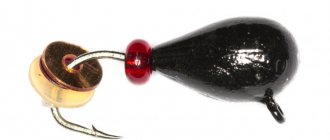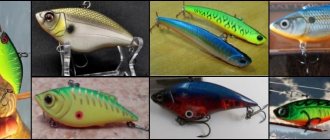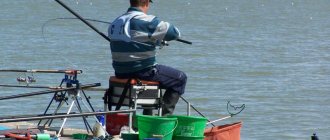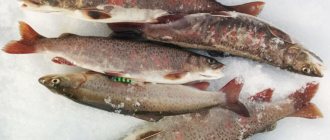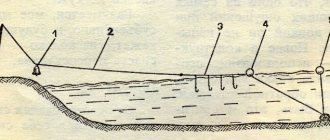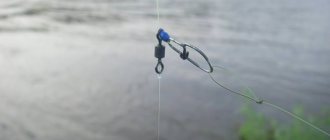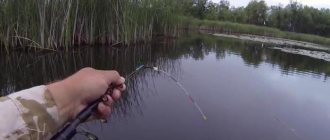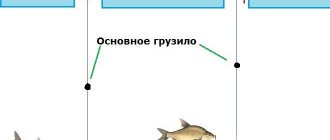Currently, fishing stores offer a huge number of baits for winter pike perch fishing. However, you definitely need to pay attention to such bait as amphipod. An amphipod is a spinner that is used to plumb a predator.
The bait received this name due to its ability to move sideways when retrieving. Therefore, catching pike perch using amphipods thanks to the original game often turns out to be quite effective. In addition, amphipods, moving in a circle, make it possible to examine large areas in a short time.
Description of the bait
In fact, amphipod is a metal horizontal spoon in the form of a small fish with the following features:
- a tee soldered into the tail or a single hook;
- wool tassel edges;
- the presence of a hole in the center of the body;
- displacement of the center of gravity relative to the central axis;
- one side of the bait is flat, the other is convex.
The latter circumstance makes it possible for the bait, gliding down, to roll from side to side. This is what led to the name “amphipod”.
Interesting! Our artificial bait has nothing in common with the amphipod, a popular bait in some places.
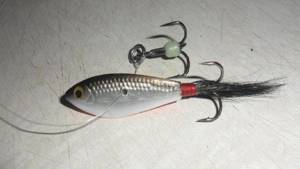
Additionally, the amphipod is equipped with a hanging tee, often equipped with a plastic droplet made of light-accumulating material.
How to properly attach amphipods
This bait is mounted as follows:
- you need to pass the fishing line through the hole in the body of the spoon so that the convex side of the bait is closer to the tackle;
- put on a bead or silicone damper - this element should protect the knot from being broken by bait;
- tie a tee to the fishing line.
Thus, the amphipod attached to the tackle has a fairly large degree of freedom, which contributes to good play. The damper may not be used - the thicker the line and the lighter the bait, the less relevant it is.
Reference! You can also attach the amphipod “upside down” - that is, run the line from the back side of the bait, so that the concave side is located closer to the tackle. In this case, the play of the spoon will be less sweeping and active, which may come in handy when catching sluggish fish.
How to properly mount amphipods is shown in this video:
Varieties
Amphipods for winter fishing differ in the following characteristics:
- type of soldered hook;
- size and weight;
- coloring
A single hook is used when fishing for pike perch in winter using amphipods in strong places, for example, in snags. On a clean bottom, a bait equipped with a tee is chosen as a more hooky option.
The size of the bait is selected according to the expected size of the trophy: for smaller perch - up to 50 millimeters, for larger pike and pike perch - from 70 millimeters and above.
The weight of the bait used depends mainly on the depth of the fishing point; the deeper, the heavier, so that the bait sinks faster into the working horizon at the bottom.
As for color, many experienced fishermen tie it to the air temperature - the colder it is, the darker it is:
- in severe frost - copper, reddish, other dark colors;
- in average cold – yellow, golden tones;
- in the thaw - light, silvery, natural.

Your arsenal should include baits of different shapes, sizes and colors.
Tackle used
To catch predators using amphipods, the same winter lures are used as for balance fishing. This is a short fishing rod up to 80 centimeters long with a hard elastic whip, equipped with a modern multiplier or small spinning reel.
Choosing a good reel can make all the difference in your fishing experience. After all, a high-quality model can be easily adjusted by adjusting the clutch to suit any trophy.
The fishing line is mainly monofilament, fishing from ice on braid is problematic, it freezes faster, and you can’t do it without special impregnations. The diameter depends on the weight of the bait and the size of the intended predator.
Typically, a line with a diameter of approximately 0.14 millimeters is used for perch, and 0.18–0.25 millimeters for pike perch.

The controversy surrounding the use of a nod on a winter lure continues. Some anglers need it, others fish based on tactile sensations.
Mounting the bait
Unlike a spoon, balancer or jig, which are attached directly to the main fishing line, amphipods are mounted differently.
- The fishing line is passed into the central hole of the bait. In this case, the convex side of the amphipod should be located on top.
- After the amphipod, a bead is placed on the fishing line to protect the knot.
- Tie a tee. It, in turn, is decorated with cambrics, wool, lurex or light-accumulating drops.
Important! When fishing for pike with amphipods, it is not a bad idea to use a metal leash. It is mounted between the main line and the tee. Recommended length 30–50 centimeters.
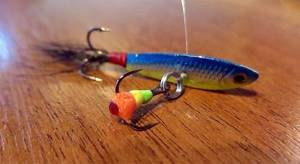
The tee can be tied to the fishing line not directly, but through a winding ring or swivel.
Do-it-yourself amphipod - making amphipod
Despite the fact that amphipods can now be bought, it is believed that there are no truly catchy baits on sale, and that catchable amphipods can only be made with your own hands. However, those who make amphipods for sale do not want to share their secrets. That’s why it’s so difficult to find a manufacturing diagram or drawing of a working bait on the Internet.
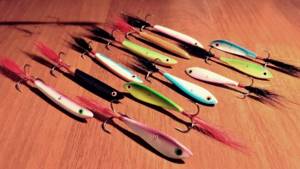
Homemade amphipods
The simplest and most logical way out of this situation is to copy a catchy bait. More difficult, but correct, is to develop and manufacture your own amphipod model, even if based on others.
In making amphipods, everything is important and matters. Centering, tail stiffness, or even the size of the outboard tee can seriously affect the amphipod's play pattern and catchability.
Amphipods can be made by casting into a mold and by soldering solder onto one or two side plates. Let's consider the simplest and most accessible method of manufacturing without a mold - by surfacing solder onto one plate.
To make amphipods with your own hands, you will need the following materials:
- Sheet brass, copper, bronze or stainless steel;
- Lead-tin solder and phosphoric acid for tinning;
- Treble hook, goat hair and tail threads;
- Waterproof glue and paint (if the bait is painted).
Tools and accessories:
- A template from which the side of the bait or frame for extrusion is cut;
- Soldering iron for soldering solder onto a plate;
- Needles and sandpaper for rough and fine finishing, and polishing paste for finishing (if painting is not used).
Manufacturing process
The side of the bait can be curved but flat, or have a complex convex (concave) shape. In the first case, the workpiece is cut to the shape of the template and bent. In the second, the workpiece is shaped by extrusion.
Next, the process of making amphipods proceeds in the following order:
- The side part and fore-end of the tail tee are tinned with solder after acid stripping;
- Using the surfacing method with a soldering iron, we apply a sufficient amount of solder to the plate, leveling it on the surface as required, while simultaneously installing the tail tee;
- We process the amphipod preparation with a file and sandpaper;
- Polish the bait blank with paste if it will not be painted. Painting should be done on a rough surface after degreasing with alcohol or solvent;
- We mount the wool tail on the tee using thread and glue;
- We determine the center of gravity of the bait for the hole, mark it and drill with a thin drill up to 2 mm. You can install a PVC tube in the hole to protect the fishing line.
A hole in the amphipod can be drilled after roughly processing the bait with a file or sandpaper. After installing the plumage, you can test the bait in the water, and depending on the behavior, make adjustments to the shape of the amphipod. After the desired performance of the bait has been achieved, we proceed to polishing or painting it.
To maintain shine, a polished bait should be coated with a colorless waterproof varnish.
How to tie Amphipod - installation
The amphipod is suspended from the fishing line with the convex side up. Suspended on the contrary, it loses the sweeping nature of the game, which is sometimes used when catching a passive predator.
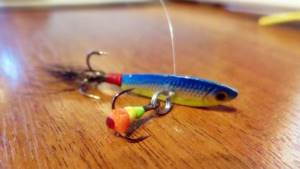
We use a fishing line from 0.2 to 0.3 mm in diameter, or fluorocarbon - it hardly stretches when hooking and does not deform during fishing like regular monofilament. Since the Wasp rotates a lot, we install a swivel above the bait, but if the line does not twist, you can do without it.
- We pass the fishing line through the hole of the bait;
- We string a bead or rubber ball onto the fishing line as a damper between the knot and the bait;
- We tie the hinged tee to the winding ring that was previously placed on it.
Installation of the amphipod looks like this:
Fishing objects
Most of our usual predators are caught using amphipods; peaceful fish are caught exclusively in bycatch, and even then, for the most part, they accidentally turn purple.
Perch
In terms of effectiveness of use on the river robber, the amphipod competes on equal terms with the balance beam. The perch also grabs it actively and greedily. The only problem is that one of the tees becomes heavily swallowed, but with the help of the appropriate tool the fish can be easily freed.
Zander
The fanged predator mainly travels in packs during the period of first ice or last ice. At this time, the choice of bait is not so important; the pike perch grabs everything with the same greed:
- and a spinner;
- and balancer;
- and amphipod.
But during the deep winter, when the flock is dispersed over a vast territory, it is the play of the amphipod that best tempts the pike perch to bite.
Attention! The absence of a front hook in amphipods often results in empty bites. This means that the pike perch hit the head of the bait.
Bersh
Bersh, unlike his cousin pike perch, is better seduced by slow retrieval, and he stands closer to the channel edge. All this must be taken into account when catching this fish.
Pike
Pike responds better to slow retrieval of amphipods with a slight inclination. In this case, you need to use a smooth fluorocarbon or metal leader, which easily slides inside the bait, but at the same time protects the line from the teeth of a predator.
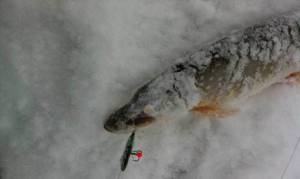
The pike in the reservoir is higher than the pike perch and bersh, so most often it attacks behind the soldered tee.
Amphipod for pike perch
As we have already said, pike perch is the fish that is most often caught using amphipods. Any amphipod for pike perch is a bait that catches it while others are “resting.”
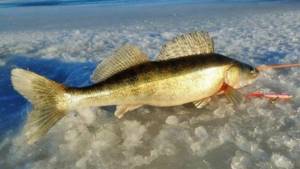
Pike perch on amphipod
What is typical is that catching pike perch on amphipods occurs in the correct way - strictly in the mouth; there are practically no cases of the fish turning purple. A pike perch bite on it can be felt as a clear blow, toss, or pressing down. Sometimes small poking or pinching is felt; in this case, hooking most often does nothing.
When searching for pike perch with amphipods, do not spend a lot of time fishing holes. Here, an 8 by 8 balancing wiring is suitable - eight strokes with a pause after the reset of up to 8 seconds. If there is a pike perch nearby, he will take it.
Fishing tactics
What lures to use for pike on a spinning rod
First of all, upon arriving at a reservoir, you need to examine the most likely fish sites. During the first ice, pike and perch are searched for in the coastal zone, where they rise, following the fry.
Pike perch and bersh do not stand still, but constantly follow schools of white fish, which move along a closed curve. Here the tactics can be twofold:
- Moving behind the moving schools of pike perch, marking the next stop site with catches. From the outside it seems that the mass of fishermen is moving chaotically across the water area, but this is a consequence of the movement of the fish.
- Waiting at the catch point. Such places are located at a fracture or bend in the underwater relief, near snags, at the border of underwater shell rock or vegetation.
In mid-winter, fish should be looked for in places with running water or underwater springs. Any predator moves to an area of oxygen-rich water.
On the last ice, points with an influx of spring meltwater, carrying oxygen under the ice crust, work best. These are again shallow waters, the confluence of streams and tributaries.
Attention! A modern device - an echo sounder - will help you find a school of fish of interest. It will eliminate the need to drill a large number of holes to determine the depth of the reservoir and its topography.
There are also different fish activity levels during the day:
- Early morning is considered optimal for catching bersh and pike.
- Over time, by midday the perch become active. And a second wave of pike emergence is also observed.
- Evening is mainly the time for pike perch to bite.
The given recommendations are very conditional; the given data can vary greatly on each specific reservoir and during different periods of winter.
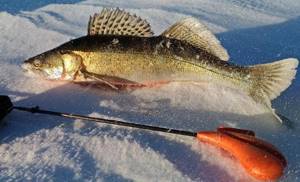
In order not to be left without a catch, you sometimes have to fish from dawn to dusk.
Amphipods for winter fishing: fishing features, installation of amphipods
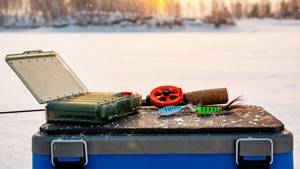
Winter fishing is a separate art form, and success in it depends on many factors - the experience of the fisherman, gear, choice of place, bait. There are many winter baits on the market today, and one of the most interesting is amphipod. Many people associate this name with a small freshwater crustacean often used as bait, but ice fishing amphipods have nothing in common with it. Outwardly, it looks like a small fish, and got its name due to its behavior in water - it rolls from side to side, thus attracting predators. You can fish for amphipods both in winter from ice and in summer from a boat.
Amphipod Dancer No. 7052 color 87 Helios 200 for 1 piece. Amphipod Dancer No. 7052 color 96 Helios 200 for 1 piece. Amphipod “Classic - 15 g” (color 07 silver, gold black) ProfiLux 182 for 1 piece. Amphipod Dancer No. 7052 color 81 Helios 200 for 1 piece. Amphipod Dancer No. 7052 color 91 Helios 200 for 1 piece. Amphipod No. 11 Premier Fishing 139 for 1 piece. Amphipod “Classic - 10 g” (color 07 silver, gold black) ProfiLux 182 for 1 piece. Amphipod OSSA 15H Lucky John 264 for 1 piece. Amphipod OSSA 13H Lucky John 264 for 1 piece. Amphipod Osa, color 07 Surf 200 for 1 piece.
Choose a catchable amphipod
What is amphipod?
For fishing to be successful, you need to understand the operating principle of the chosen bait. Amphipod is a successful alternative to other lures, capable of stirring up even passive fish that ignore other types of proposed baits.
The main advantage of this horizontal spinner is its unique action, which can be changed by wisely using different fishing methods. This way you can fish a large area with just one type of bait. Among the shortcomings, some fishermen note the absence of a lower tee, but this can always be corrected with your own hands. To make the bait attractive, the tail part is decorated with a woolen tassel.
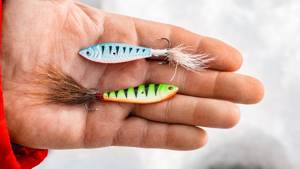
Amphipods are made from the same alloys as other winter lures - lead, tin, copper. Weighty baits are used at great depths and strong currents; in calm waters it is more advisable to use lighter models. Although amphipods are distinguished by weight, size and color, there is no clear classification of this bait. These products are cast, soldered, and can be equipped with a single or triple hook.
Amphipods were originally used for catching pike perch, but other predators, such as pike and perch, also bite well on them. If we compare the amphipod with the balancer, then the amphipod has an advantage for catching nimble fish.
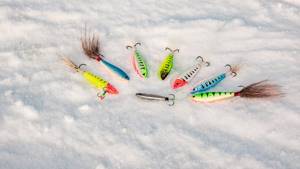
Amphipod equipment
There are no tricks in equipping amphipods; we collect standard winter gear:
- It is better to choose a rod with a length of no more than 60 centimeters, while the whip can be hard or soft. If the handle of the fishing rod is straight, then select a whip with a hard tip, and if you are more accustomed to a shaped handle, which makes it possible to make a hook with the movement of the hand, then a soft whip will be appropriate here.
Winter fishing rod. HFTC-3 with carbon whip reel (HFTC-3C-R) Helios 775 for 1 pc. Winter fishing rod Ice Battle 45 carbon (N-IB45) Nisus 855 for 1 pc. Rod PERCH Soft 51cm Salmo 1,993 for 1 piece. Winter rod. C-Tech PERCH Soft 50 cm Lucky John 2 133 for 1 piece. Winter fishing rod Ice Sensor EVA 55 Hard (N-ISE55H) Nisus 1,240 for 1 piece. Winter fishing rod Tele-Pro 65 (N-TP65-3) Nisus 855 for 1 pc. Winter rod PAN/SEAT yellow 24 GRIP Cara NOBLE 1,151 for 1 piece. Winter rods in the catalog
- Winter inertial reel. Choose a model that is comfortable for you, it should be lightweight and durable.
Reel Black Betty FreeFall 2.5:1 Gear Ratio -Trigger System w/ NEW Line Window - Left H 13 Fishing 11,350 for 1 piece.
Reel NORD 42mm Nisus (N-D500-40) Nisus 570 for 1 pc. Reel NORD PRO 62mm Nisus (N-PRO-D500-60) Nisus 745 for 1 pc. Reel NORD 52mm Nisus (N-D500-50) Nisus 585 for 1 pc. Winter reel Arctic Char 60 mm PRO Stinger 815 for 1 pc. Winter reel Arctic Char 70 mm XP Stinger 605 for 1 pc. Reel Nelma-Z-3 (right-handed) Colored body Nelma 2,770 for 1 pc. Inertial reel KP-64 Luxe (right-hand side) Black body Nelma 2,750 for 1 piece. Coil cartoon MAIKO 6.5 cm Lucky John 2 352 for 1 piece. Winter reels in stock
- Fishing line. A high-quality monofilament is perfect for fishing with amphipods. Its thickness for fishing a predator must be at least 0.25 mm so that the prey does not break the fishing line.
- A leash is used only when there is a high probability of catching pike or pike perch in the reservoir where you are going to fish. Without a leash, this predator breaks the line and leaves along with the bait. The leash can be made of tungsten or fluorocarbon, no more than 25 centimeters long.
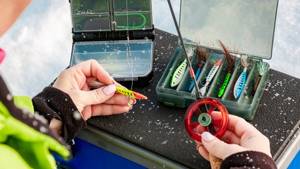
How to tie an amphipod
There are several ways to install amphipods.
Classical
The bait lies with the convex side up, a fishing line is threaded through the hole in the middle, then we fold the fishing line in half to make a figure eight, form a loop, rewind its base four times and tighten it. We thread the resulting loop into the ring of the additional tee, after which we throw it over the amphipod’s tail and tighten it again. The bait is ready.
Installation of amphipod with beads
We pass the fishing line through the hole in the amphipod, as in the method described above, after which we thread it through the bead and form a loop, pass the fishing line through the ring on the tee, put a loop on it and tighten it. As you can see, both methods are quite simple, you can choose either one, and both are suitable for winter fishing. Equipping an amphipod with a tee is not necessary; each fisherman decides for himself.

How to fish with amphipods
In general, fishing with amphipods in winter is not much different from the same fishing with a balance beam, however, there are some tricks here too. First you need to find the habitat of the intended prey. The best option would be a body of water that has already been studied, since in winter the predator is very passive and rarely leaves its habitable places. It usually hides behind flooded snags or in holes. Perch and pike often hide near the shore.
If the reservoir is new, then an echo sounder will help you find a high concentration of fish. Without this useful device, you will have to drill many holes at random, looking for irregularities on the bottom where fish may be hiding.
You can fish for amphipods at any time of the day, in the early morning there is a good bite for pike and garish, towards noon the perch becomes more active, and in the evening there is a chance to catch pike perch. Fishing for amphipods is especially successful in windless and frosty weather.
On a well-known reservoir, first drill several holes, moving from the shore to the middle of the reservoir. There is no need to remove the snow cover, as the sun's rays can scare away hidden fish. The optimal distance between holes when searching for interesting terrain is 10-20 meters. To determine a good place for fishing, you need to make about 10 wires in each hole.
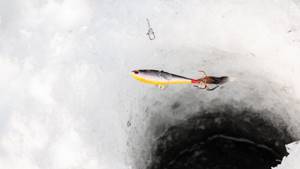
Amphipod fishing technique
There are no difficulties here - we lower the bait to the bottom, then raise it by 5-10 centimeters, after which we smoothly raise the amphipod 30 cm above the bottom surface, then there is a sharp drop to the original point. After an eight-second pause, you can continue playing the amphipod again. This is a great way to attract even a passive and capricious predator. Fishermen call this technique 8x8, where the first eight is a pause of 8 seconds, and the second is the number of retrieves. If after eight repetitions there is no bite, move on to the next hole. Well, if the bite has started, then the place has been chosen correctly and you shouldn’t leave it just yet.
When the working hole goes quiet, a few more are drilled at a distance of two to three meters from it. When retrieving, carefully monitor the fishing line and the tip of the rod, because in winter the fish are not so active, and even a pike bite can be unnoticeable. Sometimes a bite can be signaled by a slightly noticeable nod or lifting of the whip.
In addition to the classic wiring method, there are others:
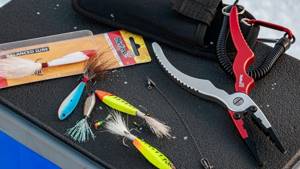
Balance wiring
, in which the toss of amphipods by 10-12 cm must be alternated with pauses, the duration of which is determined only experimentally;
Jig and muscle wiring
, when to attract fish you need to create the illusion of the fry moving. To do this, we make slow, smooth movements with the fishing rod, thanks to which the bait will sway, rotating around its axis;
Asynchronous or stepped wiring
. This method is different from others. First, we lift the amphipod from the bottom, after which, playing with the bait, we carefully lower it down. Such a stepped dive, alternating with smooth ascents, can interest even a very cautious and timid predator. If there is no bite, then you can move to another place, lift the bait a few centimeters up and continue the game, or increase the range of movements.
Often fishermen, preparing for winter fishing for amphipods, try to make the bait more catchable, for which they decorate it with additional beads and colored cambrics.
We advise you to prepare the installation of amphipods at home, without going out into the cold. Directly on the pond, all you have to do is attach the finished amphipod to the leash. This makes it easier and faster to select working bait in specific weather conditions on site. It is convenient to store mounted amphipods in boxes with compartments for bait.
Box 36x22x5cm (HS-ZY-049) Helios 565 for 1 pc. Box 18x11x4.5cm double-sided (HS-K-DS-18x11x4.5) Helios 645 for 1 pc. Box 13.2x10.5x3.3cm for wobblers, balancers (HS-L-1) Helios 210 for 1 pc. Box 2-3600-00 Plano 920 for 1 pc. Box 23x11.5x6cm double-sided (HS-TB-4500) Helios 335 for 1 pc. Fishing box (7006) Salmo 135 for 1 pc. Box TOP BOX LB-1700 (20*17*5 cm), orange base, 20 pcs/pack. TOP BOX 360 for 1 piece. Box for lures LCB 2-sided. 200x126x36 yellow/clear top (#100-P21-Y) PONTOON21 1,028 for 1 piece.
-30%
Box 3701-00 Plano 1 210 847 for 1 piece. Box 8.8x19x3.2cm (HS-L-85) Helios 155 for 1 pc.
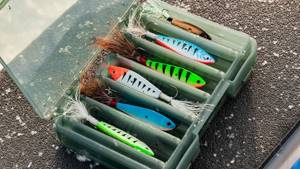
Tight lines to you, our winter fishermen!

Fishing technique
Having found the optimal depth difference, we begin fishing. The technique of fishing with amphipods is in many ways similar to that with a balancer. Since pike perch are mainly caught with this bait, we will describe the game with bait for it, noting that smaller movements are made to catch perch, and when fishing for pike, wider and smoother movements are made.
So, to catch pike perch, we do this:
- We lower the bait into the bottom horizon and place it 5–10 centimeters from the ground.
- We make a sharp stroke with the brush until the fishing rod is almost vertical, then sharply lower it to its original position.
- We pause; most often the bite occurs precisely at this phase. Its duration ranges from five to thirty seconds, depending on the activity of the fish: the more passive the pike perch, the longer the pause. While waiting, you can lightly play along with the tip of the spoon, making smooth swings with an amplitude of one or two centimeters.
- After making 5–7 repetitions, we raise the bait by 25–30 centimeters and again do several repetitions. Having reached the edge of the ice, we repeat the same thing in another hole.
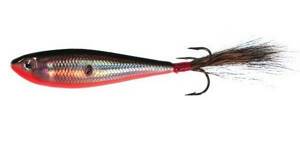
Some of the catchiest amphipods are the baits of the Lucky John company.
The above recommendations are not dogma; any animation should always be modified and some additions made to it:
- make movements smoother;
- shorten or lengthen throws;
- move the amphipod from side to side;
- make jig steps.
Where to fish
I think everyone knows that pike perch ambushes near various water obstacles in winter. Therefore, most fishermen try experimentally, making numerous holes in an attempt to detect irregularities and changes in depth - holes and edges.
Then holes are made in the intended location, at a distance of about 5 meters from each other. Each hole is fished using both standard fishing methods and the figure-of-eight principle, which was described earlier.
